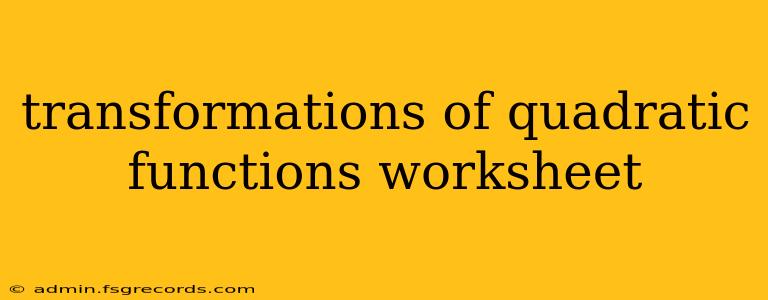Quadratic functions, represented by the general form f(x) = ax² + bx + c, undergo fascinating transformations when we adjust their parameters. Understanding these transformations is crucial for graphing and analyzing quadratic equations. This guide delves into the core concepts and provides a framework for tackling any worksheet on quadratic function transformations.
Understanding the Core Transformations
The key to mastering quadratic function transformations lies in recognizing how changes to the equation affect the parabola's position and orientation. We'll focus on four primary transformations:
1. Vertical Shifts (Vertical Translations)
A vertical shift moves the entire parabola up or down along the y-axis. This is controlled by adding or subtracting a constant value, 'k', to the function:
- f(x) + k: Shifts the graph up by 'k' units.
- f(x) - k: Shifts the graph down by 'k' units.
Example: If f(x) = x², then f(x) + 3 shifts the parabola three units upward.
2. Horizontal Shifts (Horizontal Translations)
A horizontal shift moves the parabola left or right along the x-axis. This involves adding or subtracting a constant value, 'h', inside the function's parentheses:
- f(x - h): Shifts the graph right by 'h' units.
- f(x + h): Shifts the graph left by 'h' units. (Note the counter-intuitive nature here!)
Example: If f(x) = x², then f(x - 2) shifts the parabola two units to the right.
3. Vertical Stretches and Compressions
These transformations alter the parabola's vertical scale. They are controlled by multiplying the entire function by a constant value, 'a':
- a * f(x): If |a| > 1, it stretches the parabola vertically. If 0 < |a| < 1, it compresses the parabola vertically.
- -f(x): Reflects the parabola across the x-axis (vertical reflection).
Example: If f(x) = x², then 2f(x) = 2x² stretches the parabola vertically by a factor of 2. -f(x) = -x² reflects it across the x-axis.
4. Horizontal Stretches and Compressions
These transformations affect the parabola's horizontal scale. They involve modifying the 'x' value before the squaring operation. This is less commonly explicitly shown, but it's crucial to understand:
- f(bx): If |b| > 1, it compresses the parabola horizontally. If 0 < |b| < 1, it stretches the parabola horizontally.
- f(-x): Reflects the parabola across the y-axis (horizontal reflection).
Example: Understanding this transformation often requires working with the vertex form, discussed below.
The Vertex Form: A Powerful Tool
The vertex form of a quadratic function, f(x) = a(x - h)² + k, beautifully encapsulates all the transformations. Here:
- (h, k): Represents the vertex (the parabola's turning point).
- 'a': Controls the vertical stretch/compression and reflection.
By identifying 'a', 'h', and 'k' in the vertex form, you can instantly determine the transformations applied to the basic parabola, y = x².
Tackling Worksheet Problems: A Step-by-Step Approach
- Identify the Parent Function: This is usually f(x) = x².
- Determine the Transformations: Analyze the given quadratic function and identify the values of 'a', 'h', and 'k' (if it's in vertex form) or deduce the transformations from the equation's structure.
- Apply the Transformations Sequentially: Consider the order of operations. Horizontal shifts and stretches/compressions should generally be applied before vertical shifts and stretches/compressions.
- Graph the Transformed Parabola: Use your knowledge of the transformations to accurately sketch the parabola, labeling the vertex and key points.
- Verify Your Work: If possible, check your answers by substituting x-values into the original equation and comparing with the graphed points.
By systematically applying these steps, you can confidently tackle any worksheet on transformations of quadratic functions. Remember to practice regularly, and you'll soon master this essential concept in algebra.

